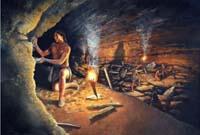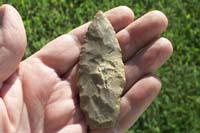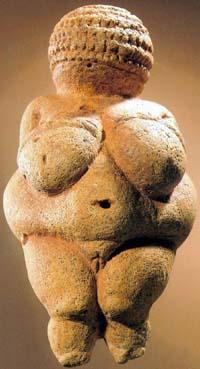New image of prehistoric women

Until recently anthropologists have attributed their main role to man.
Photo: National Park Service
It is not easy to know how our ancestors lived. Anthropologists rely on footprints and ethnology, but footprints are not as abundant and clear as to draw clear conclusions. Therefore, it is understandable that those who interpret these traces have to rely on something else in explaining what prehistoric times were like. And they often rely on what they live and see. It is therefore no wonder that the Palaeolithic woman assumed the traditional role of a submissive woman. Hunters, artists and shamans must necessarily be men.
But anthropology, like society itself, is constantly advancing. Scientists have more data and vestiges than a few years ago, and probably less prejudice. Therefore, several experts have questioned the image of the domestic and dependent woman and have otherwise looked at the prehistoric. Consequently, it seems that the Paleolithic has also reached the age of gender equality, and the image of the prehistoric woman they have presented lately is now more colorful and alive than before. Of course, we don't know if it comes closer to the truth than to the image above!
However, according to the new trend, Paleolithic women also practiced hunting, for example. The same weapons were not used as men, but there are indications that women also hunted animals. Ethnological studies also bet on it. For example, women from the Canadian Ojbwa tribe and those from the Tiwi tribe of Astralia also hunt and the weapons they use for it are not like those of men.

Research on the bushmen tribe of southern Africa also helped anthropologists open their eyes and see otherwise the social structure and role sharing. Anthropologists thought that our ancestors lived like them! The research took place about thirty years ago and since then life has changed, but before they were nomads and the woman was not limited to taking care of the house and children. He was not dependent on man when it came to getting food and was dedicated to collecting food and hunting.
Woman hunter and collector
According to experts, it is very likely that society and, consequently, the role of women will change from the Palaeolithic to the Neolithic. In the Neolithic period man became a farmer and farmer, new activities that demanded a more specialized division of labor than before. But there is no reason to think that women did not participate in obtaining food in the Paleolithic.

Teamwork and strength were essential for hunting large animals, so man has been given a primary role. The animal he hunted was a hero. The woman, for her part, had to collect, clean, crush and prepare the hunt or, according to another version, settle for the waste. In addition, the woman should keep something for children and adults.
However, studying the utensils and parts of the animals they ate, several anthropologists have concluded that hunting was not the main activity in the Paleolithic. Surely other predators tried to catch the dead animals. That is, like the vulture and the hyena, the man would be more scavenger than hunter. And in that activity, apparently, both men and women. Others have gone further and suggested that the authors of the fine tools were women, who invented rope and textile 20,000 years ago.
Gender

When they try to explain what life was like in the Paleolithic, they often talk about sex. When they have imagined the sexual activity of the time and the role of women, experts have mentioned everything. Some believe that men used women as exchange caps. The typical image of the woman, in which the man dominated completely, is that the man takes her from the butterfly and drags her. It's a caricature, yes, but that was the image and conviction that existed until a few decades ago.
But this idea changed a lot when feminism gained strength. The statues of Paleolithic women have been interpreted in various ways, for example, as a symbol of matriarchy by the feminists of the 1970s. In fact, the idea was not new, as the Greeks imagined primitive societies dominated by women in some Aegean islands and in the Asian steppe. Feminists, however, built the theory on the basis of these states and spread much since then.
It is clear: The image of the Paleolithic woman has changed over time and in the future new interpretations will continue. Not only because more signs will be obtained, but because the very look also changes
Published in 7K.
Buletina
Bidali zure helbide elektronikoa eta jaso asteroko buletina zure sarrera-ontzian











